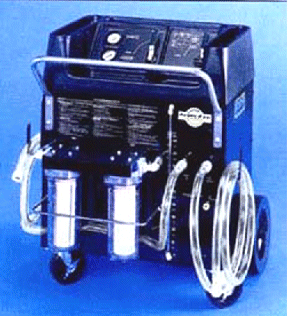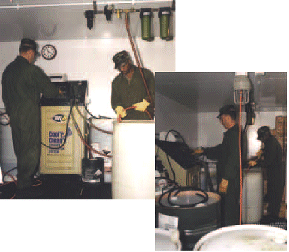Recycling of spent antifreeze
solutions is a viable alternative to disposal. Waste antifreeze may be considered
a hazardous waste in some states due to the toxicity of the ethylene glycol
component, the toxicity of the products of degradation/oxidation of ethylene
glycol, and/or the heavy metals content.
Several reclamation systems are currently available for on-site recycling
of waste antifreeze. There are two DOD-approved recycling systems
for waste anti-freeze originally procured under MIL-A-46153. In February
1997, MIL-A-46153 was replaced with Commercial Item Description (CID)
A-A-52624 "Antifreeze, Multi Engine Type". This new antifreeze
covers three types of fully formulated coolants: Type I is an ethylene
glycol (EG) based antifreeze concentrate; Type IP is a prediluted EG-based
coolant with 60% by volume glycol; and Type II is a propylene glycol (PG)
based antifreeze concentrate. CID A-A-52624 is based on ASTM performance
specifications D 6210 and D 6211 for fully formulated EG- and PG-based
engine coolants. According to USA-TACOM TARDEC, MIL-A-46153 and
EG-based versions of CID A-A-52624 (Types I and IP) can be mixed for the
purpose of recycling. However, EG-based and PG-based coolants should still
be segregated for recycling purposes.
The DOD-approved antifreeze recycling systems use ion exchange and vacuum
distillation as the primary separation/purification processes. These systems
filter solids from the spent antifreeze, as well as remove the metal ion
contaminants from the solution. The recovered coolant solution often requires
blending with an inhibitor package to restore it to its initial state.
The two DOD-approved recycling systems can work with either ethylene glycol
or propylene glycol, although each coolant must be processed separately.
These systems are relatively simple to operate, compact (~4’ x 4’), portable
(they are mounted on wheels or can be mounted on a trailer or truck), and
easy to maintain.
The distillation system produces the larger quantity of waste
residue of the two recycling systems. Residue production is approximately
3 gallons of residue per 75 gallons of spent antifreeze. This residue may
be hazardous waste since the lead contamination is often greater than 5 ppm,
but only a Toxicity Characteristics Leaching Procedure [TCLP] analysis can
determine whether the waste has this hazardous characteristic. The manufacturer
of this unit claims that a batch of accumulated residue can itself be processed
to reduce further the total volume of waste produced.
The ion exchange unit does not produce any liquid hazardous waste residue;
however, it does require filter replacement. Spent filters accumulate metals
and may be considered hazardous waste if disposed. Once the ion exchange
filters are spent they must be shipped back to the manufacturer for regeneration.
The spent filters are not generally treated as a hazardous waste since they
are re-used after regeneration and are not disposed.
Off-site recycling of antifreeze is another option to consider. Some
companies will charge for recycling the antifreeze and for restoring it
to standard specifications so that it may be returned to the original user.
Other companies charge a handling fee, and recycle/restore the antifreeze to
sell to other users. In addition, DSCR Product Center 4 is beginning to offer
recycled antifreeze products through the supply system.


